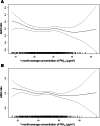Outdoor air pollution and diminished ovarian reserve among infertile Korean women
- PMID: 33573606
- PMCID: PMC7879617
- DOI: 10.1186/s12199-021-00942-4
Outdoor air pollution and diminished ovarian reserve among infertile Korean women
Abstract
Background: Mounting evidence implicates an association between ambient air pollution and impaired reproductive potential of human. Our study aimed to assess the association between air pollution and ovarian reserve in young, infertile women.
Methods: Our study included 2276 Korean women who attended a single fertility center in 2016-2018. Women's exposure to air pollution was assessed using concentrations of particulate matter (PM10 and PM2.5), nitrogen dioxide (NO2), carbon monoxide (CO), sulfur dioxide (SO2), and ozone (O3) that had been collected at 269 air quality monitoring sites. Exposure estimates were computed for 1, 3, 6, and 12 months prior to the ovarian reserve tests. Anti-Müllerian hormone (AMH) ratio (defined as an observed-to-expected AMH based on age) and low AMH (defined as < 0.5 ng/mL) were employed as indicators of ovarian reserve. We included a clustering effect of 177 districts in generalized estimating equations approach. A secondary analysis was conducted restricting the analyses to Seoul residents to examine the association in highly urbanized setting.
Results: The mean age was 36.6 ± 4.2 years and AMH level was 3.3 ± 3.1 ng/mL in the study population. Average AMH ratio was 0.8 ± 0.7 and low AMH was observed in 10.3% of women (n=235). The average concentration of six air pollutants was not different between the normal ovarian reserve and low AMH groups for all averaging periods. In multivariable models, an interquartile range (IQR)-increase in 1 month-average PM10 was associated with decrease in AMH ratio among total population (β= -0.06, 95% confidence interval: -0.11, 0.00). When we restrict our analysis to those living in Seoul, IQR-increases in 1 and 12 month-average PM2.5 were associated with 3% (95% CI: -0.07, 0.00) and 10% (95% CI: -0.18, -0.01) decrease in AMH ratio. The ORs per IQR increase in the six air pollutants were close to null in total population and Seoul residents.
Conclusions: In a cohort of infertile Korean women, there was a suggestive evidence of the negative association between ambient PM concentration and ovarian reserve, highlighting the potential adverse impact of air pollution on women's fertility.
Keywords: Air pollution; Anti-Müllerian hormone; Fertility; Ovarian reserve.
Conflict of interest statement
The authors declare that they have no competing interests.
Figures

Similar articles
-
Exposure to air pollution and ovarian reserve parameters.Sci Rep. 2024 Jan 3;14(1):461. doi: 10.1038/s41598-023-50753-6. Sci Rep. 2024. PMID: 38172170 Free PMC article.
-
Association of exposure to ozone and fine particulate matter with ovarian reserve among women with infertility.Environ Pollut. 2024 Jan 1;340(Pt 1):122845. doi: 10.1016/j.envpol.2023.122845. Epub 2023 Nov 3. Environ Pollut. 2024. PMID: 37926414
-
Effects of short-term exposure to air pollution on hospital admissions of young children for acute lower respiratory infections in Ho Chi Minh City, Vietnam.Res Rep Health Eff Inst. 2012 Jun;(169):5-72; discussion 73-83. Res Rep Health Eff Inst. 2012. PMID: 22849236
-
Association between exposure to ambient air pollution and hospital admission, incidence, and mortality of stroke: an updated systematic review and meta-analysis of more than 23 million participants.Environ Health Prev Med. 2021 Jan 26;26(1):15. doi: 10.1186/s12199-021-00937-1. Environ Health Prev Med. 2021. PMID: 33499804 Free PMC article.
-
Air pollutants and ovarian reserve: a systematic review of the evidence.Front Public Health. 2024 Sep 23;12:1425876. doi: 10.3389/fpubh.2024.1425876. eCollection 2024. Front Public Health. 2024. PMID: 39376999 Free PMC article.
Cited by
-
The Chemical Exposome on Ovarian Aging in Adult Women: a Narrative Review.Curr Pollut Rep. 2025 Dec;11(1):13. doi: 10.1007/s40726-025-00341-1. Epub 2025 Feb 19. Curr Pollut Rep. 2025. PMID: 40584973
-
Fine particulate matter and ovarian health: A review of emerging risks.Heliyon. 2024 Nov 19;10(22):e40503. doi: 10.1016/j.heliyon.2024.e40503. eCollection 2024 Nov 30. Heliyon. 2024. PMID: 39650185 Free PMC article. Review.
-
Exposure to air pollution and ovarian reserve parameters.Sci Rep. 2024 Jan 3;14(1):461. doi: 10.1038/s41598-023-50753-6. Sci Rep. 2024. PMID: 38172170 Free PMC article.
-
Poor ovarian response is associated with air pollutants: A multicentre study in China.EBioMedicine. 2022 Jul;81:104084. doi: 10.1016/j.ebiom.2022.104084. Epub 2022 May 31. EBioMedicine. 2022. PMID: 35660784 Free PMC article.
-
Potential factors result in diminished ovarian reserve: a comprehensive review.J Ovarian Res. 2023 Oct 25;16(1):208. doi: 10.1186/s13048-023-01296-x. J Ovarian Res. 2023. PMID: 37880734 Free PMC article. Review.
References
MeSH terms
Substances
Grants and funding
LinkOut - more resources
Full Text Sources
Other Literature Sources
Medical
